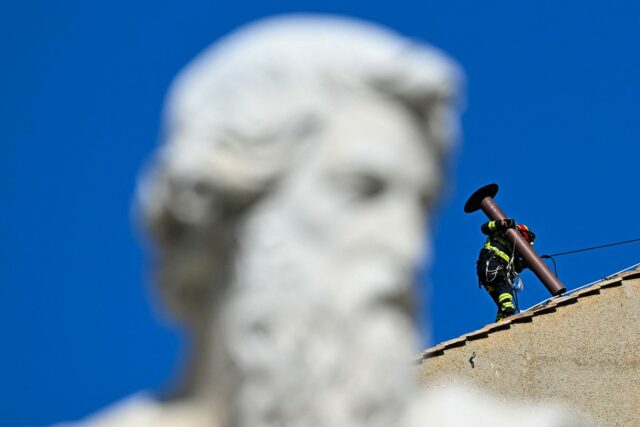Firefighters on Friday constructed the chimney atop the Sistine Chapel, which will release white smoke to signify the election of a new pope, five days before cardinals assemble for the conclave.
Following Pope Francis’s death on April 21, 133 Catholic cardinals will convene beneath Michelangelo’s renowned frescoes in the 15th-century chapel located inside the Apostolic Palace at the Vatican to choose a successor.
The conclave, which is being held behind locked doors, will use a special stove to burn ballots and produce black smoke if no one has been elected or white smoke if a new pope has been chosen to announce the outcome to the world.
As he entered the meeting on Friday morning, Cardinal Gregorio Rosa Chavez, 82, told reporters, “I think the Church is in prayer mode, but it must also put itself in surprise mode.”
“Recall the shocking event involving Pope Francis!”
* ‘Once in a lifetime’ –
Among the hordes of tourists and pilgrims in St Peter’s Square on Friday morning, the installation of the chimney on the Sistine Chapel – a narrow metal tube with a capped top — went completely unnoticed.
However, many knew that history was being made.
Glenn Atherton, a British visitor from London, stated, “It is undoubtedly a historic moment and it feels special to be in Rome.”
He told AFP, “It feels like a once-in-a-lifetime thing.”
Two cardinals have withdrawn for health reasons, leaving the remaining 135 cardinals eligible to vote in the conclave.
On Wednesday, May 7, the conclave is scheduled to start at 4:30 p.m. (1430 GMT), when the cardinals will swear an oath promising to keep the election secret or face excommunication.
They will only hold one poll on that first day, and the winner—really any baptized male, but in practice always one of their own—needs 89 votes, or a two-thirds majority, to win.
Two votes will be held in the morning and two in the afternoon during the next few days.
If a winner is elected, the ballots will be burned in the special stove with the addition of chemicals to generate white smoke to alert the waiting world to the verdict.
If no candidate receives enough votes during the first-morning vote, the cardinals will proceed to a second vote, and only after that moment will the ballots be burnt.
It is the same process in the afternoon session: if a pope is elected, there will be white smoke; if not, the cardinals will vote again, and only then will the votes be burnt.
If no pope is elected, the smoke that comes out of the chimney is black.
The ancient signaling system — still the only way the public learns whether a pope has been elected — used to involve mixing wet straw with the ballots to produce white smoke and tarry pitch to create black smoke.
After several episodes in which greyish smoke caused confusion, the Vatican introduced a new system in 2005.
At the last conclave in 2013, the Vatican said it used a mixture of potassium perchlorate, anthracene, and sulfur to produce black smoke and potassium chlorate, lactose, and rosin for white.
Two stoves stand in a corner of the chapel, one for burning the ballots and the other for the chemicals, with the smoke from both stoves going up a common flue, it said back then.
Details for the procedure of next week’s conclave have not yet been confirmed.





